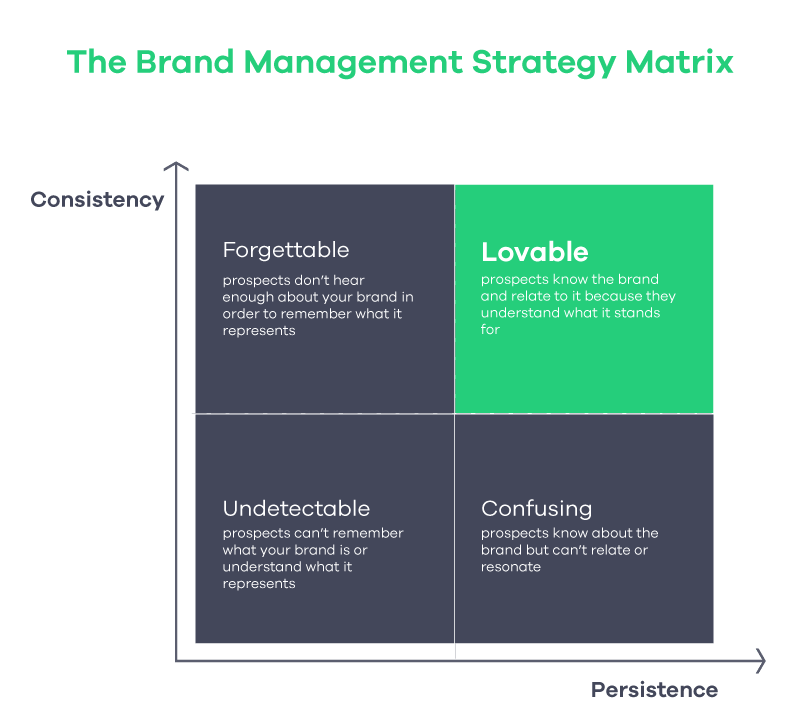Well, hello there dear loyal reader or new-comer. Excited to be pouring my rambling industry thoughts here once again. This time, I bring to you the evergreen topic of brand management. Never-ending, never-solved, always to-be-improved. Yes, the company’s brand is still the almighty concept and entity in marketing and as shiny as VR, experiential campaigns, and viral content is, without the brand, we’ve got nothing.
I won’t assume you need a 5-paragraph definition of what brand management is. But, I do feel I need to scare marketers into turning around and taking another good look at their brand and how it’s kept and guarded. Only when we’re all panicked, I’ll deep dive into how to design the brand management ecosystem that will, indeed, ensure your business stability.
Also, the first part of this article is for the haters. And I had a genius idea that my colleagues rolled their eyes at. To take on this article as you, dear reader, would be a skeptic. A hater. A “no man!”. So here we go.
1. Do you really need brand management?
Yes. You really really do. The brand still is, and dare I say will continue to be the backbone of anything we do as marketers. In case you haven’t read any of my articles before, it’s a good time to mention a disclaimer: I’m a big fan of metaphors. I believe we, as marketers for a company, should all pull into a certain direction – the brand’s direction. If even one strays away, we never manage to have any progress. Or at best, we’re inefficient in getting where we want to go. So what is brand management?
As Brand24’s Community & Marketing Specialist Gloria Ziencina-Kawula says:
“I would also add that in our current online world brand managing is crucial. This consists of building brand awareness, managing online reputation, public relations on social media, social selling, social media customer care, real-time marketing, crisis prevention, and problem-solving.”
Let’s speak more than just brand management definition. The company’s brand is everything to its customers and prospects. And think about it, you don’t leave up to chance the one aspect that represents everything to your target. You have to manage it. And do so responsibly, with thought-out planning, and taking into account any detail that could affect or improve something.
Us marketers have creative souls and a constant eagerness to get the ball rolling. Launch that idea. Publish that content. Run that campaign. It’s amazing what we sometimes manage to achieve with little resources and close to no time. But, as amazing as we are, our work can be dangerous to the brand if it’s not well managed. If our company’s branding strategy is vague or not well communicated, we put everything at risk.
2. Really, what can happen due to poor or lack of brand management?
Overdramatic? Don’t think so. Seriously, where were you when Kylie Jenner opened that can of Pepsi? Or when H&M decided to put the wrong hoodie on the wrong child? The outcome is obvious.
With a well-structured branding strategy, a solid brand management system, and a flawless communication workflow, there should have never been fire. But I understand what you might be thinking – ok these are doomsday scenarios. A brand that’s not well governed by brand managers doesn’t always turn into a huge PR crisis, right?
True, I admit it. But I already told you I’m here to drive us into panic mode. That doesn’t mean you should put your feet up just yet. There’s still a lot of consequences that may have a major impact on your brand and efforts.
One of them is exactly what I started with. Your customers and prospects are there for a reason. They resonated with what you seemed to be through one of your public apparitions. Whether that was a piece of content, a social media post, a speech, a meme, it was something that made them say: “huh, I like these guys”. That something should be a core part of your brand. And it should be reflected in all your future outputs. If something your company does or says contradicts that initial impression, you risk losing many of those customers or prospects.
Another argument is that the brand in itself is forever in a building and maintenance process. There’s no particular end or final goal it can achieve. The issue with that is that every brick should be put in the right place. Otherwise, it’ll quickly turn into a bad game of Jenga. A moved brick can tear down the entire thing.
3. Ok, fine. What’s in it for the company if there’s strong brand management?
Good question – congratulations, my imaginary hater! Strong brand management strategy isn’t important only because when it lacks, it can go very very wrong. On its own, it can highly benefit the actual results of your marketing and overall business.
The math is simple really. The more your prospects understand who you represent, the more they trust you. The easier they buy. The more they stay. In specific terms, strong brand building increases awareness, acquisition, and retention.
With every piece of marketing material that your followers see their picture of your company becomes a bit clearer, the blurs start fading away, and pixels get sharper. That’s why it is so important to truly fix up your brand management. And ensure it’s reflected in every process and project you have.
4. I get it. But back to your title. Can brand management really ensure business stability?
It can in many ways. Of course, it’s not the only factor and without a product, the company will still fail. However, without driving the hypothesis to absurd scenarios, the stability of the brand can define the overall stability of the business. Rocking the brand will inevitably rock the business.
If you don’t believe me, see what Eugenio Perrier Advisor – Marketing & Business Development @ Halla says:
This has been already shown in so many ways and so often. Each PR crisis, each time a company took a step outside the direction their brand was perceived in, their sales paid the price. And it’s doable for Pepsi, H&M, or Dove to bounce back. As long as they do it fast. And smart. But if you’re not working for one of the giants of this world, bouncing back is a bit harder. The pillows aren’t as soft for companies less known. And so strategic brand management should become an even higher priority.
5. Ok, how can you sustain strong brand management?
I’d say there are two concepts that lay at the base of successful brand management: persistence and consistency. And because charts make the world a better place, at least my world, here’s one that should shine some light on this:
Yes, that did just come out of my own brain. Yes, I am proud of it. Thank you.
Long story short, in order for a brand to not only stand out but also capture the hearts of its prospects, it has to be both consistent and persistent. Without consistency, prospects will give up easily since they can’t relate or figure out what the brand stands for.
Do they resonate with its principles? Do they like what it stands for? In order for a prospect to answer these questions, they have to understand what the brand actually is. And don’t expect them to do their own homework to understand a brand they’ve barely heard of.
If you’ve nailed consistency and are confident that if someone took a look at all or any of your content, it’d be clear what your brand represents, it’s time to bring on persistence. Produce more valuable content. Get out into the world. Prospects are ready to see and hear about you.
Without persistence in content and promotion, you’re forgettable, and best-case scenario, it takes a very long time for the audience to feel a connection.
6. That all sounds nice and well, but how does a brand achieve consistency and persistence?
Ok, so the reason I assume my skeptics would ask this is because we’re all tired of vague concepts with no clear action plans. So it’s time to move on to the actual how-tos. Here’s the split of these principles:
1. Strategy-wise
2. Processes-wise
These are the angles and categories where a team has to zoom in to establish a flawless brand management system. We will now deep-dive into each of them.
6.1. How to secure brand management strategy-wise?
When it comes to the strategy of your brand and marketing, it’s important for it to be clear, flexible, and transparent.
Here’s what Graham Robertson, Founder/CMO @ Beloved Brands thinks:
Clarity. The clarity that I’m referring to in this case is much more than what initially meets the eye.
Let’s start by agreeing that a beautifully written doc covering the brand’s strategy that gets shared across the team will not guarantee clarity. In order for the branding strategy to be truly grasped by the marketing team, it needs to be explained, discussed, debated.
I’d advise this clarity to start from the Brand Manager directly. It should be the person in the company who understands what the brand is best and has the ability to truly get across the entirety of the concept to the team. In the meetings or docs where the brand is explained, make sure each term is interpreted as well. Also, don’t forget that negative brand mentions might significantly damage your reputation and your SEO strategy so this is an area you need to pay a lot of attention.
For example, don’t just say our brand is friendly and assume every marketer will understand “friendly” in the same way your brand manager does. Dive deeper. What exactly is friendly? How friendly? How should that be reflected in the tone of voice, design, copy, colors, channels, content formats, etc.
Flexibility. Yes, in order for a brand to be consistent, it needs clear guidelines and a somewhat rigidity to how it’s portrayed and communicated. When I say flexibility, I am not referring to what the brand represents, but on how the brand is portrayed.
Real brand management shouldn’t be implemented through guidelines such as: “our photos are always red”. These kinds of statements underestimate marketers, limit their creativity, and ultimately sends great talent away. Be open to exploring how your brand should communicate and present itself to the world.
Transparency. Branding strategy shouldn’t only be clear and communicated well, but it should be as transparent as possible within the company. Transparency, in this case, refers to the ‘reason-whys’ behind your strategic brand management. Involve the critical part of your marketers, not only their execution skills. Explain why your company wants its brand to be what it is.
6.2. How to ensure brand management processes-wise?
We have already established just how important it is to have perfect brand management in place. I wanted to re-touch base on this because I’m afraid at this point you’ll close this article thinking ‘ok, I’ve got it’. And I really don’t want you to. Because ensuring all marketers understand your brand management strategy is not enough.
Once again, us marketers get easily excited about our ideas and campaigns and have a tendency to just jump into it. It’s hard to be hands on and eagle-view at the same time. That’s why the processes have to be put in place in order to achieve stable offline and digital brand management.
Processes are really different from one team to another so I won’t go into too many details as to what they should be. What I would advise is to:
Ensure clear feedback processes: the idea here is to firstly establish a feedback-centered culture and make sure your team truly understands feedback is good for everyone.
Stakeholders within the company should be involved in whatever the team creates and it’s good for the quality of the output, the relationship with stakeholders, and the brand’s consistency.
The second point here is that clarity in these processes will increase speed and therefore avoid frustration. Who gives feedback? Why? From what point of view? Where does this feedback loop take place? How long should each feedback loop take at max?
Establish who gets looped in and when: We all know that there are multiple steps in a marketing process from ideation to planning, creation, design, publishing, promoting, and repurposing.
It’s important to truly mark who gets involved when. If the brand manager is involved, when is he looped in? Should PR know as soon as the idea came to the team?
Define approval flows in detail: When it comes to approval, there are three things to establish: ‘who has to give approval?’, ‘what does approval mean?’, and ‘what is the final greenlight?’. These answers will eliminate unnecessary lags in marketing plans and will avoid mistakes or PR crisis.
This is just a glimpse of how marketing workflows and processes should look like but the truth is I could write a book on what defines an ideal marketing workflow. Oh wait, my colleague already did that – he published a book called “Marketing Teams of The Future” that I really really recommend. Oh, and you can download it here:
That’s about it from me, folks. If you’ve made it so far, thank you, hope it was worth it. If it wasn’t do let me know – as you’ve seen, I love ma’ haters!

Miruna Dragomir, CMO @Planable, ex Social Media Comms Manager @Oracle & ex Marketing Coordinator @Uber. 9 years of experience in social media and marketing. Built Planable’s brand and reputation and helped grow it from 50 customers to over 6.5K. Social media fanatic, tech geek & a sucker for learning.










